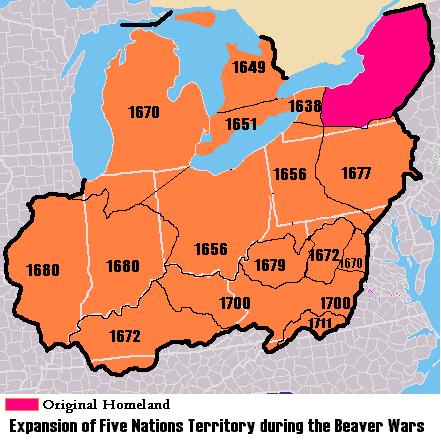
A series of wars that continued long-standing conflicts among native people, but added the participation of Europeans and introduction of European weapons. The native rivals were the Wendat or [[Dan's History Web/US 1/Topic Index/Huron]] people and their [[Dan's History Web/US 1/Topic Index/Algonquin]] allies, against the [[Dan's History Web/US 1/Topic Index/Iroquois|Haudenosaunee]] or Iroquois Confederacy, a political union of five tribes of what is now New York. Although the league was probably much older, the member tribes had been severely depopulated by disease in previous generations (the [[Dan's History Web/US 1/Topic Index/Columbian Exchange]]) and warfare was a way to replenish their numbers with captives who could be "adopted" into bands and the tribe, in an ancient tradition of the native world. The Haudenosaunee had previously invited the Wendat to join their confederacy, but the Wendat had turned them down. To a great extent, the Iroquois-Huron conflict was a "[Mourning War](https://chenussio.geneseo.sunycreate.cloud/overview-of-seneca-history/mourning-wars/)".
Europeans became involved when [[Dan's History Web/US 1/Topic Index/Samuel de Champlain]] entered a battle on the side of his new allies the Huron and Algonquin in 1609, against the (Iroquois) [[Dan's History Web/US 1/Topic Index/Mohawk]], on the shores of Lake Champlain. The Frenchman single-handedly killed two Iroquois war chiefs with his [harquebus](https://en.wikipedia.org/wiki/Arquebus). Five years later, the Dutch built a fort and trading post on the [[Dan's History Web/US 1/Topic Index/Hudson River]] at what became [[Dan's History Web/US 1/Topic Index/Albany]], and the Iroquois found an ally who would not only fight with them, but who would provide guns, powder, and shot in exchange for beaver pelts and other furs. In 1628 the Mohawks defeated the ([[Dan's History Web/US 1/Topic Index/Algonquian]]) [[Dan's History Web/US 1/Topic Index/Mohican|Mohicans]] and drove them out of their traditional territory, into western Massachusetts. The French were willing to fight beside their native allies, but they would not sell them guns; so the balance of power began to whift in favor of the Iroquois.
In 1641, the Mohawk sent emissaries to [[Dan's History Web/US 1/Topic Index/New France]] to propose an alliance with the French and set up a trading post, but their proposal was rejected. In the 1650s, the Iroquois began attacking the French themselves, and by 1650 they controlled territory up to the [[Dan's History Web/US 1/Topic Index/St. Lawrence River]]. When they defeated the Algonquian Shawnee and drove them out of the [[Dan's History Web/US 1/Topic Index/Ohio River]] valley, the Iroquois seized the land all the way to the [[Dan's History Web/US 1/Topic Index/Mississippi River|Mississippi]]. The French counterattack involved burning Iroquois villages and food stores, a technique alien to native warfare. In the 1660s, French armies were sent to engage with the Mohawk, who were the most active tribe of the confederacy in the fighting. French successes led to a peace treaty in 1667.
In the later 1660s, after they had replaced the Dutch in New York, the English took over the alliance and trade agreements with the Iroquois and continued supplying guns. In the 1670s, the new French governor, [Frontenac](https://en.wikipedia.org/wiki/Louis_de_Buade_de_Frontenac), resumed the fur trade by allowing the French to supply guns to their allies. In 1681, [[Dan's History Web/US 1/Topic Index/La Salle]] negotiated a traty with the Miami and Illinois tribes, which had been driven from their lands by the advancing Iroquois. During [King William's War](https://en.wikipedia.org/wiki/King_William%27s_War), French and Indian raiding parties attacked English settlements in New York, New Hampshire, and Maine. The English and Iroquois attacked La Prairie, on the south shore of the St. Lawrence River in Canada. But by the end of the seventeenth century, some Iroquois were beginning to suspect that the English colonies might be as dangerous to them as any other Europeans, so they made peace with France.

For more info on Mourning Wars: https://chenussio.geneseo.sunycreate.cloud/overview-of-seneca-history/mourning-wars/